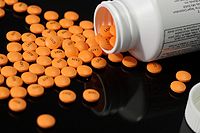
Photo from wikipedia
RSV-induced prostaglandin D2 release contributes to disease severity by impairing IFN-λ production. RSV gives innate immunity the runaround Asthma can be exacerbated by pathogens such as respiratory syncytial virus (RSV);… Click to show full abstract
RSV-induced prostaglandin D2 release contributes to disease severity by impairing IFN-λ production. RSV gives innate immunity the runaround Asthma can be exacerbated by pathogens such as respiratory syncytial virus (RSV); prostaglandin D2 (PGD2) is also important in asthma and is being investigated as a therapeutic target. Werder et al. used multiple models to examine how RSV infection may perturb immune responses and influence asthma pathogenesis. Samples from infants with bronchiolitis or primary pediatric epithelial cells infected with RSV had elevated PGD2. Modulating PGD2 signaling in a mouse model of severe bronchiolitis improved antiviral immunity and dampened asthmatic symptoms later in life. This protection was not due to preventing type 2 immunity but instead a restoration of IFN-λ production. Their findings shed light on this host-pathogen interaction and suggest new therapeutic avenues. Prostaglandin D2 (PGD2) signals through PGD2 receptor 2 (DP2, also known as CRTH2) on type 2 effector cells to promote asthma pathogenesis; however, little is known about its role during respiratory syncytial virus (RSV) bronchiolitis, a major risk factor for asthma development. We show that RSV infection up-regulated hematopoietic prostaglandin D synthase expression and increased PGD2 release by cultured human primary airway epithelial cells (AECs). Moreover, PGD2 production was elevated in nasopharyngeal samples from young infants hospitalized with RSV bronchiolitis compared to healthy controls. In a neonatal mouse model of severe viral bronchiolitis, DP2 antagonism decreased viral load, immunopathology, and morbidity and ablated the predisposition for subsequent asthma onset in later life. This protective response was abolished upon dual DP1/DP2 antagonism and replicated with a specific DP1 agonist. Rather than mediating an effect via type 2 inflammation, the beneficial effects of DP2 blockade or DP1 agonism were associated with increased interferon-λ (IFN-λ) [interleukin-28A/B (IL-28A/B)] expression and were lost upon IL-28A neutralization. In RSV-infected AEC cultures, DP1 activation up-regulated IFN-λ production, which, in turn, increased IFN-stimulated gene expression, accelerating viral clearance. Our findings suggest that DP2 antagonists or DP1 agonists may be useful antivirals for the treatment of viral bronchiolitis and possibly as primary preventatives for asthma.
Journal Title: Science Translational Medicine
Year Published: 2018
Link to full text (if available)
Share on Social Media: Sign Up to like & get
recommendations!